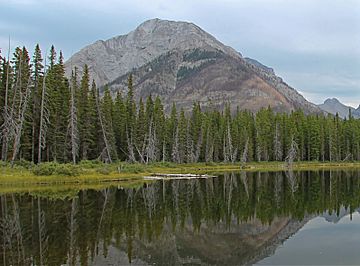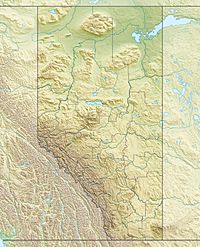Mount Buller (Alberta) facts for kids
Quick facts for kids Mount Buller |
|
|---|---|
| Buller Mountain | |

Mt. Buller seen from Buller Pond
|
|
| Highest point | |
| Elevation | 2,805 m (9,203 ft) |
| Parent peak | Mount Bogart (3144 m) |
| Listing | Mountains of Alberta |
| Geography | |
| Location | Alberta, Canada |
| Parent range | Kananaskis Range |
| Topo map | NTS 82J/14 |
| Climbing | |
| First ascent | 1956 by B. Fraser, M. Hicks, J. Gorril |
| Easiest route | Moderate scramble if upper slabs are snow free |
Mount Buller is a mountain in the Kananaskis Range in Alberta, Canada. It stands tall at 2,805 meters (9,199 feet) above sea level.
The mountain was officially named in 1922. It got its name from Lieutenant Colonel H.C. Buller, a brave soldier who died during World War I.
How Mount Buller Was Formed
Mount Buller is made up of different kinds of sedimentary rock. This type of rock forms from layers of mud, sand, and tiny bits of plants and animals that build up over millions of years.
Ancient Rock Layers
The rocks that make up Mount Buller were laid down during very old time periods. These include the Precambrian and Jurassic periods. Imagine shallow ancient seas where these layers slowly formed.
Mountain Building Forces
Later, huge forces deep within the Earth pushed these rock layers. This event is called the Laramide orogeny. It caused the sedimentary rock to move east and stack on top of younger rock. This process slowly lifted and folded the land, creating the mighty mountains we see today, including Mount Buller.
Weather and Climate at Mount Buller
Mount Buller has a subarctic climate. This means it has very cold, snowy winters and mild summers.
Winter Conditions
During winter, temperatures can drop below -20 degrees Celsius (-4 degrees Fahrenheit). With the wind chill, it can feel even colder, sometimes below -30 degrees Celsius (-22 degrees Fahrenheit).
Water Flow
When snow melts or rain falls on the mountain, the water flows down its sides. This water eventually drains west into the Spray Lakes Reservoir.


